Pork Carcass Evaluation and Procedures
Effective methods of pork carcass evaluation are based on the pork industry's desire to improve productivity and product quality. Carcass evaluation is essential in determining carcass value differences at the market place. The pork producer must be concerned about production of edible pork which is acceptable by the consumer. In addition, this product must be of acceptable quality for the meat processor.
Pork carcass evaluation systems that are used in swine improvement programs and carcass contests should place major emphasis on those traits that contribute most to the economic value of the carcass. For this reason, major emphasis is usually given to those factors that are good indicators of lean yield.
It is the purpose of this fact sheet to describe quantitative and qualitative characteristics associated with pork carcass desirability and to identify procedures that can be standardized and applied to measure these characteristics throughout the pork industry.
Predicting Lean Yield
Several methods are available for evaluation of the expected lean yield in a pork carcass. The method selected will often be dictated by the facilities and manpower that are available for collecting the needed information. For example, the most accurate method of lean determination is a complete physical separation of the lean, fat and bone in the carcass. However, the knife skill and labor required make this a highly impractical method for most swine improvement programs.
On the other hand, one of the simplest techniques is the application of the USDA Grades for Pork Carcasses, or a modification thereof, which requires no cutting of the carcass and in most instances can be done by trained personnel as a totally visual appraisal. While the official USDA Grades for Pork Carcasses are rarely used, modifications of the system are used extensively by the packing industry for grade and yield buying programs and carcass evaluation. Most swine improvement programs, carcass contests, etc., require greater accuracy than is possible with the USDA carcass grades. Also the USDA carcass grades do not differentiate small value differences.
Currently the most practical method of evaluating carcass leanness appears to be through the use of a regression equation similar to that which has been used for several years to establish beef yield grades. An explanation on how to use this system follows:
Estimating % Carcass Lean
1. Hot carcass weight, loin eye area (LEA) at the 10th rib, and fat depth over the loin eye are accurately measured.
2. To estimate pounds of carcass muscle, use Table 1 to determine the conversion value for each of the above three traits.
3. Add the three conversion factors. The total equals the estimated pounds of muscle (containing about 10% fat) that a given carcass should yield. For example:
Carcass Wt. 164 (CV=29.30); LEA 6.4 (CV=37.50); 10th Rib Fat 0.60 (CV=34.40) or
29.30 + 37.50 + 34.40 = 101.20 Ibs of muscle.
If Table 1 is not available or when the measures fall outside the range shown in the table, the following equation can be used:
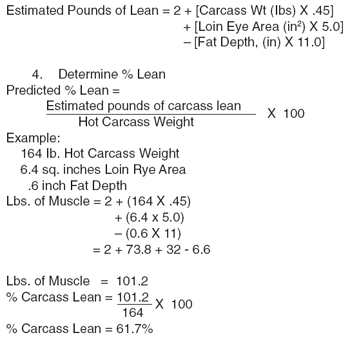
Table 1. Conversion Values for Determining Pounds of Carcass Muscle.
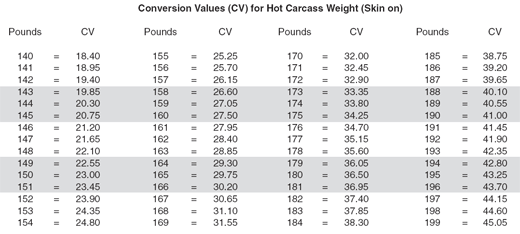
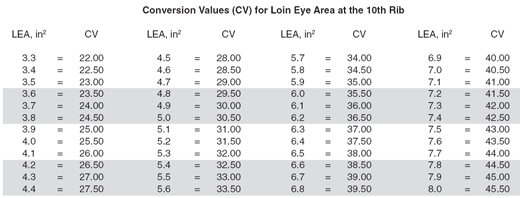

Carcass Measurement Procedures
Hot Carcass Weight
Most pork processing plants have a scale located at the end of the slaughter line just before the carcasses enter the cooler. Carcass weight should be obtained at this point; however, if this is not possible, chilled carcass weight can be converted to a hot weight basis by dividing by .985. For skinned carcasses adjust to "skin on basis" by dividing the hot weight by .94 (skin accounts for about 6% of hot carcass weight).
Carcass Weight Adjustment
All carcasses should be examined visually to determine the extent to which inspectors may have trimmed the carcasses to remove bruises, abscesses, etc. Carcasses having more than 3% (4.5 - 5.5 Ibs.) trim loss should not be considered for competition. When the loss is less than 3%, the number of pounds should be estimated and added to hot carcass weight.
Carcass Length
If carcasses are required to meet the standards of the "All Breed Swine Certification Program" adopted by the National Association of Swine Records, the carcass length should be measured before the carcass is ribbed.
Carcass length is measured in a straight line from the forward edge of the first rib to the forward edge of the aitch bone (Figure 1.)
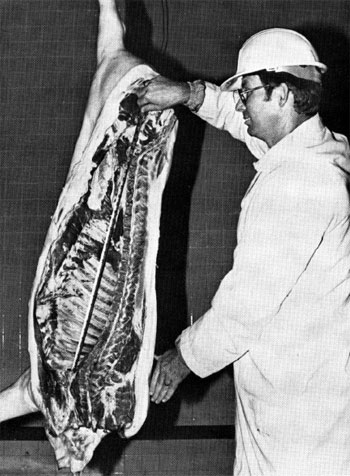
Figure 1. Measuring Carcass Length.
Carcass length has little or no relationship to lean yield or carcass merit; however, longer hogs are usually considered to be more productive in the breeding herd and feedlot. Therefore, a minimum length of carcass of 29.5 inches (adjusted to 220 pounds live weight) has been established for eligibility in most carcass contests.
Average Backfat Thickness
When the "All Breed Swine Certification Standards" are used, carcasses must average less than 1.5 inches of backfat thickness (adjusted to 220 Ibs. live wt.) to be eligible for carcass placing.
This measure may be obtained either by averaging the three measures of backfat opposite the first rib, last rib, and last lumbar vertebra (Figure 2) or converting the known 10th Rib Fat Depth measurement to Estimated Average Backfat Thickness using the following table:
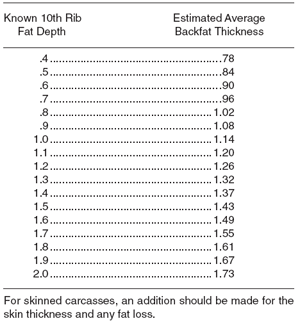
Ribbing the Hanging Carcass
This is accomplished by cutting near the junction of the 10th and 11th thoracic vertebrae with a ribbing saw. The cut should be made perpendicular to the length of carcass just below the 11th rib. After sawing through the vertebra, use a knife to cut perpendicular across the long axis of rib eye. (The rib eye area will be affected if this cut is made with the curvature of the ribs). The cut can be extended only about 1.5 inches beyond the ventral edge of the loin eye (longissimus muscle) without cutting into the belly (Figure 3).
Loin Eye Area (LEA)
Place a plastic grid over the loin eye and count the dots or squares that fall within the boundaries of the longissimus muscle. DO NOT INCLUDE THE SMALL MUSCLES SURROUNDING THE LONGISSIMUS. Convert to square inches by dividing the number of dots or squares by the appropriate conversion factor on the grid (Figure 4). When the "All Breed Swine Certification Standards" are used, carcasses must
have 4.5 square inches of loin eye (adjusted to 220 Ibs. live weight) to be eligible.
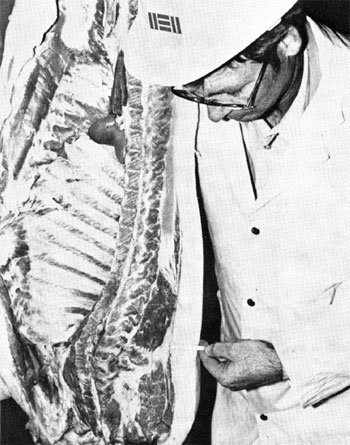
Figure 2a. Backfat Thickness: First Rib.
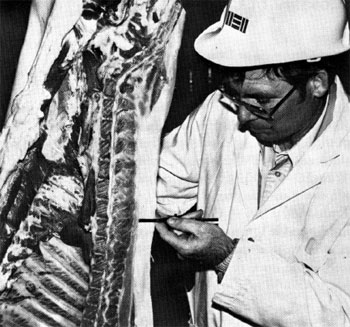
Figure 2b. Backfat Thickness: Last Rib.
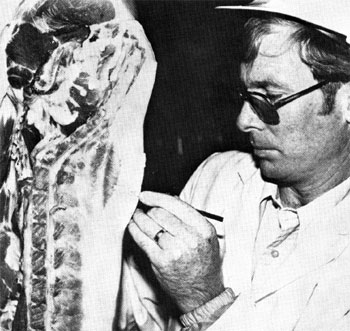
Figure 2c. Backfat Thickness: Last Lumbar Vertebra.
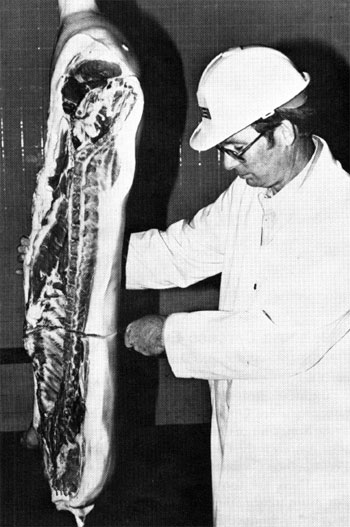
Figure 3. Ribbing the Hanging Carcass.
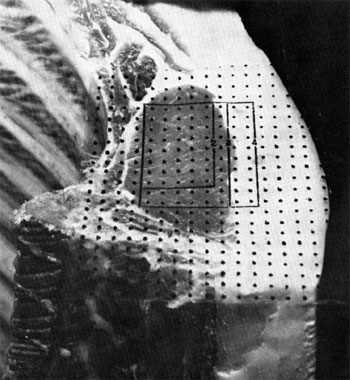
Figure 4. Loin Eye Area (LEA).
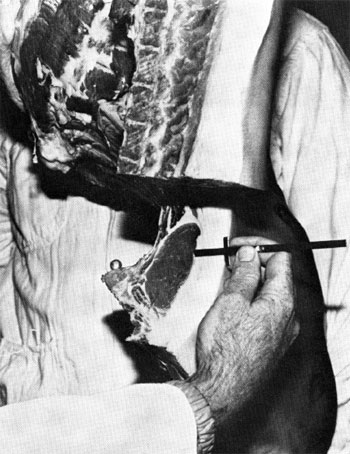
Figure 5. Measuring Fat Depth.
Fat Depth
Using a backfat probe or other instrument graduated in 1/10 inch increments, measure the fat depth including the skin at the 3/4 point over the rib eye (Figure 5).
Divide the longest axis of the loin eye muscle into quarters. Measure the fat depth at the 3/4 point from the outer edge of the muscle to a point at the outer edge of and perpendicular to the skin.
Qualitative Characteristics
Pork carcass quality is sometimes evaluated more precisely than the "acceptable - unacceptable" designations in the pork grade standards. Desirable fresh pork quality is defined as a combination of physical traits providing for an edible product that loses a minimum of constituents, is attractive in appearance, and is appetizing, nutritious, and palatable after cooking. The predictors of pork quality are muscle color, muscle firmness of the loin eye and firmness of fat. The scoring system for the two factors are as follows:
| Score | |
| Dark, very firm, very dry | 5.0 |
| Moderately dark, firm, dry | 4.0 |
| Uniformly grayish pink, moderately firm and dry | 3.0 |
Pale, moderately soft, moderately watery |
2.0 |
| Extremely pale, soft, watery muscle | 1.0 |
Pork muscle should be bright grayish pink to pinkish red. It is recommended that carcasses having either of the two extreme color scores be disqualified.
Also if the loin is soft and watery and exhibits obvious fluid accumulation on the surface, and has a coarse loose texture, the carcass should be disqualified on "undesirable quality."
Carcass Weight Per Day of Age or Average Daily Gain on Test
When the date of birth of the animal can be reliably established, carcass weight per day of age can be one of the best evaluations of production efficiency for use in most carcass contests. Reliability of birth date information can be verified by ear tattooing young animals before two weeks of age. When ages can only be estimated, carcass weight per day of age should not be used in ranking carcasses. However, the best available information for date of birth may be used in determining carcass weight per day of age but use for information only.
Weight gain during a test feeding period could be used in situations where the determination of accurate birth date is not possible. Average daily gain on test would be particularly useful in evaluating animals which have been fed out at a central testing facility.
Combining gain data with an estimation of lean production could give an indication of lean meat production per day.


Oklahoma Carcass Evaluation Programs
Oklahoma pork producers are encouraged to obtain carcass evaluation of their market hogs. There are two annual statewide carcass contests available to all Oklahoma pork producers. One is the Golden Pork Chop Contest held at the State Fair of Oklahoma in Oklahoma City. Another state contest is the Oklahoma National Barrow Show and Performance Contest also held in Oklahoma City each year. There are also a few county contests in Oklahoma. For more information on these carcass contests, contact your OSU County Extension Center.
Glossary of Carcass Evaluation Terms
Lean Cuts - The ham, loin, boston butt, and picnic make up the lean cuts.
Lean Cut Yield - The combined weight of the lean cuts divided by the carcass weight times 100 gives the lean cut yield of the carcass in percentage. The combined weights of the lean cuts divided by the live weight times 100 gives the lean cut yield in percent on the live hog basis.
Primal Cuts - The ham, loin, belly, boston butt, and picnic make up the primal cuts.
Primal Cut Yield - On both the live hog and carcass basis are figured in the same manner as the lean cut yield above.
Percent Ham and Loin - This is a criteria for carcass value comparisons. A combined ham and loin weight is divided by one-half the carcass weight, is multiplied by 100, and indicates the percentage of ham and loin yield of the carcass weight.
Loin Eye Area - A term commonly used to describe a cross section of the loin or longissimus dorsi muscle. Only the "loin-eye" area is traced on acetate paper and the area is measured with the planimeter or grid and the results listed in square inches.
Dressing Percent or Yield - These two terms are generally accepted as being synonymous. Dressing percent is calculated by dividing the chilled carcass weight by the live weight and multiplying by 100.
by Frederick K. Ray - Oklahoma State University Cooperative
This article hasn't been commented yet.


Write a comment
* = required field